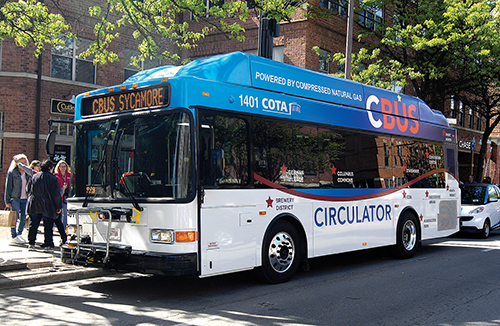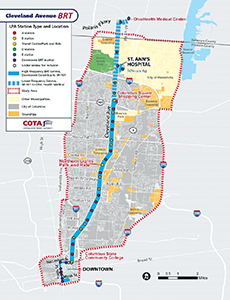
By Curtis Stitt

President/CEO
Central Ohio Transit Authority
Columbus is the largest city in Ohio and the 15th-fastest-growing city in the country. It is the only Midwestern city that experienced significant growth from 2012 to 2013. Projections indicate that by 2050 the central Ohio region will grow by 500,000 people. As the region looks ahead to this growth and the impact it will have on the community, the Central Ohio Transit Authority (COTA) is mapping out its strategic vision for the future of public transportation in the region; aligning its goals with the goals of the greater community.
—————————————————————————————————————————————
YOU MIGHT ALSO LIKE:
- Yavapai-Apache Transit connects Central Arizona
- CTfastrak to change rider experience in central Connecticut
- sbX brings BRT to the Inland Empire
—————————————————————————————————————————————
COTA intends to maximize current transit service for a solid foundation to plan and build the next generation of public transportation to meet the needs of this growing community.

CBUS enhances downtown
Since May, CBUS has enabled downtown employees, Columbus-area residents and visitors to make connections between residential districts, employment centers, dining, nightlife, cultural offerings, parks, hotels and convention facilities.
The COTA Board of Trustees has made a commitment to provide CBUS service free to the community through the end of 2014 in support of private and public sector efforts to attract residents, businesses and visitors to the revitalized core of the city. Funding models and sponsorship opportunities are being explored that would make CBUS service free indefinitely.
New Albany Park & Ride connects residents
In September, COTA will introduce reverse commute service from downtown and the Easton Transit Center to a large business park that has been developing in New Albany. While the park boasts 9,000 jobs, employers are challenged to find people to fill the jobs being created.

Recognizing that lack of accessibility is playing a role in jobs going unfilled, New Albany is partnering with COTA to find a solution. The city has contributed funds for the development of a new Park & Ride facility and has agreed to provide shuttle service that will disperse riders throughout the expansive business park.
This unique partnership will provide the connectivity needs to fill the jobs housed in the business park and further contribute to the economic development of the region.
Strengthening the Foundation
In October 2013, COTA embarked on a complete review of its bus network. The intent of this Transit System Review (TSR) is to improve the effectiveness of COTA’s bus network to meet the needs of growing and changing land uses in central Ohio. The recommendations will be constrained by COTA’s current funding levels.
The TSR, which consultants led by IBI Group are developing, assesses current service and regional characteristics through input solicited from COTA customers, community leaders and other stakeholders.
IBI Group, in conjunction with the COTA staff, developed three bus network scenarios and public feedback was sought to help COTA answer the question: How should our public transportation resources be invested?
The scenarios illustrate different ways COTA could invest its resources: maximize ridership through frequent service in areas favorable to transit; spread service throughout the region to provide some level of coverage to as many people as possible; and a midpoint combination of the ridership and coverage scenarios.
In May and June, COTA sought additional public input on a draft proposed network and draft downtown operations plan exemplifying a 70/30 percent split between ridership and coverage scenarios. These draft plans were the result of the previous round of public input, and direction provided by COTA stakeholders and the Board of Trustees.
The final deliverable, expected to be completed in September 2014, will include a proposed bus network and downtown operations plan.
Bus Rapid Transit
In 2010, COTA began working to bring Bus Rapid Transit (BRT)/Enhanced Bus Service to Cleveland Avenue in order to provide an improved transit option within one of Columbus’ busiest corridors. Local Line 1 currently serving Cleveland Avenue/Livingston is the second busiest route in the system, with ridership averaging nearly 4,800 daily weekday trips – often with standing room only.
The proposed 15.6 mile service will transport riders between downtown Columbus and Polaris Parkway/Africa Road, stopping at 74 designated locations in both directions along the way. The line will complement Line 1 and connect with existing bus routes.
The service will run primarily within mixed traffic between downtown Columbus and Polaris Parkway/Africa Road. It will operate in bus-only lanes on High Street (Columbus’ main thoroughfare) during rush hours in downtown. Traffic signals will be coordinated to provide priority for BRT buses between Fort Hayes and SR-161, reducing travel times. The line will feature 10-minute frequency of service during peak hours and 15-minute frequency of service during off-peak hours between downtown and SR-161. Service will operate seven days a week.
The preliminary project cost is $39.4 million, of which COTA is seeking 80 percent or $31.5 million in grant funding from FTA’s Section 5309 New Starts program.
The Next Generation
Even after ensuring that COTA’s goals align with the larger goals of the community and solidifying its foundation of bus service throughout the region, COTA knows its current system is not equipped to provide the service that will be needed as central Ohio continues to grow and expand.
Later this year, COTA will lead the central Ohio community in envisioning what the next generation of public transportation might look like 20, 30 or even 40 years from now. This extensive visioning process will reach out to all of the members of the community with an interest in our future transit model, and will not be fiscally constrained or restricted by transit mode.
